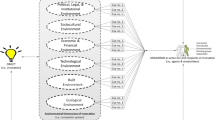Abstract
In the introductory chapter, we argued that innovation has established itself as an imperative in the public sector. We have noticed a similar increased awareness of innovation within public planning and planning theory. Starting from Friedmann’s original model of innovative planning, we present an extended theoretical framework for planning that gives innovation a distinct position. This extended framework encompasses the existing schools of calculate and communicate in planning theory, and it adds innovate as a third position. Innovative planning, as we define it, is mainly strategic, territorial, societal and co-produced change that breaks with established practices and seeks to legitimize new social objectives or effect a major reordering of the prioritization of existing objectives.
Access this chapter
Tax calculation will be finalised at checkout
Purchases are for personal use only
Similar content being viewed by others
References
Agger, A., & Sørensen, E. (2016). Managing collaborative innovation in public bureaucracies. Planning Theory, 1(21), 1–21.
Albrechts, L. (2012). Reframing strategic spatial planning by using a coproduction perspective. Planning Theory, 12(1), 46–63.
Asheim, B., & Gertler, M. S. (2005). The geography of innovation: Regional innovation systems. In J. Fagerberg, D. C. Mowery, & R. R. Nelson (Eds.), The Oxford handbook of innovation (pp. 291–318). Oxford: Oxford University Press.
Bafarasat Ziafati, A. (2015). Reflections on the three schools of thought on strategic spatial planning. Journal of Planning Literature, 30(2), 132–148. Retrieved from http://journals.sagepub.com/doi/abs/10.1177/0885412214562428
Bryson, J., Crosby, B., & Bloomberg, L. (2015). Introduction. In J. Bryson, B. Crosby, & L. Bloomberg (Eds.), Public value and public administration. Washington, DC: Georgetown University Press.
Bryson, J., Sancino, A., Benington, J., & Sørensen, E. (2017). Towards a multi-actor theory of public value co-creation. Public Management Review, 19(5), 640–654.
Edquist, C. (2005). Systems of innovation. In J. Fagerberg, D. C. Mowery, & R. R. Nelson (Eds.), The Oxford handbook of innovation (pp. 181–209). Oxford: Oxford University Press.
Fagerberg, J. (2005). Innovation: A guide to the literature. In J. Fagerberg, D. C. Mowery, & R. R. Nelson (Eds.), The Oxford handbook of innovation (pp. 1–28). Oxford: Oxford University Press.
Friedmann, J. (1966). Planning as innovation: The Chilean case. Journal of the American Institute of Planners, 32(4), 194–204.
Hagen, A., & Higdem, U. (2019). Calculate, communicate and innovate: Do we need innovate as a third position? Journal of Planning Literature, I–13. https://doi.org/10.1177/0885412219851876
Hanssen Sandkjær, G. (2012). Negotiating urban space: Challenges of political steering in market- and network-oriented urban planning. Scandinavian Political Studies, 35(1), 22–47.
Harper, T. L., & Stein, S. M. (2012). Dialogical planning in a fragmented society: Critically liberal, pragmatic, incremental (2nd printing ed.). New Brunswick, NJ: Transaction Publishers.
Hartley, J., Sørensen, E., & Torfing, J. (2013). Collaborative innovation: A viable alternative to market competition and organizational entrepreneurship. Public Administration Review, 73(6), 821–830.
Healey, P. (2006). Network complexity and the imaginative power of strategic spatial planning. In L. Albrechts & S. J. Mandelbaum (Eds.), The network society. A new context for planning? (pp. 146–160). London: Routledge.
Higdem, U. (2014). The co-creation of regional futures: Facilitating action research in regional foresight. Futures, 57, 41–50.
Higdem, U. (2015). Assessing the impact of political partnerships on coordinated meta-governance of regional government. Scandinavian Journal of Public Administration, 19(4), 89–109. Retrieved from http://ojs.ub.gu.se/ojs/index.php/sjpa/article/view/3302/2817
Higdem, U., & Sandkjær Hanssen, G. (2014). Handling the two conflicting discourses of partnerships and participation in regional planning. European Planning Studies, 22(7), 1444–1461. Retrieved from https://doi.org/10.1080/09654313.2013.791966
Hillier, J. (2008). Plan(e) speaking: A multiplanar theory of spatial planning. Planning Theory, 7(1), 24–50. https://doi.org/10.1177/1473095207085664
Hofstad, H., & Torfing, J. (2015). Collaborative innovation as a tool for environmental, economic and social sustainability in regional governance. Scandinavian Journal of Public Administration, 19(4), 49–70.
Mahoney, J., & Thelen, K. (2010). A theory of gradual institutional change. In J. Mahoney & K. Thelen (Eds.), Explaining institutional change: Ambiguity, agency and power. New York: Cambridge University Press.
Mäntysalo, R. (2002). Dilemmas in critical planning theory. Town Planning Review, 73(4), 417–436. Retrieved from https://online.liverpooluniversitypress.co.uk/doi/abs/10.3828/tpr.73.4.3
Osborne, S. P. (Ed.). (2010). The new public governance? Emerging perspectives on the theory and practise of public governance. London: Routledge.
PBA. (2008). Lov om planlegging og byggesaksbehandling. [The Planning-and building act].
Peters, G. (2010). Meta-governance and public management. In S. P. Osborne (Ed.), The new public governance? Emerging perspectives on the theory and practise of public governance. London: Routledge.
Powell, W. W., & Grodal, S. (2005). Networks of innovation. In J. Fagerberg, D. C. Mowery, & R. R. Nelson (Eds.), The Oxford handbook of innovation (pp. 56–85). Oxford: Oxford University Press.
Rittel, H. W. J., & Webber, M. M. (1973). Dilemmas in a general theory of planning. Policy Sciences, 4(2), 155–169.
Sørensen, E. (2006). Metagovernance: The changing role of politicians in processes of democratic governance. The American Review of Public Administration, 36(98), 98–114.
Sørensen, E. (2016). The role of elected politicians in collaborative policy innovation. In J. Torfing & P. Triantafiliou (Eds.), Enhancing public innovation by transforming public governance (pp. 178–196). Cambridge: Cambridge University Press.
Sørensen, E., & Waldorff, S. B. (2014). Collaborative policy innovation: Problems and potential. The Innovation Journal: The Public Sector Innovation Journal, 19. (3 article 2). Retrieved from http://www.innovation.cc/scholarly-style/19_3_2_sorensen-waldorff_collaborate-policy494f11nov.pdf
Syssner, J., & Meijer, M., 2012. Innovative planning in Rural Depopulationg Areas: Conditions, Capacities and Goals. In Hagen, A. & Higdem, U. Innovation in Public Planning. Calculate, Communicate and Innovate. London: Palgrave Macmillan.
Tewdwr-Jones, M. (1998). Collaborative planning: Shaping places in fragmented societies: P. Healey, 338 pp., 1997, Macmillan, Basingstoke. ISBN: 0-333-49573.
Author information
Authors and Affiliations
Corresponding author
Editor information
Editors and Affiliations
Rights and permissions
Copyright information
© 2020 The Author(s)
About this chapter
Cite this chapter
Hagen, A., Higdem, U. (2020). Innovation in Planning Theory: The Upcoming Perspective. In: Hagen, A., Higdem, U. (eds) Innovation in Public Planning. Palgrave Macmillan, Cham. https://doi.org/10.1007/978-3-030-46136-2_12
Download citation
DOI: https://doi.org/10.1007/978-3-030-46136-2_12
Published:
Publisher Name: Palgrave Macmillan, Cham
Print ISBN: 978-3-030-46135-5
Online ISBN: 978-3-030-46136-2
eBook Packages: Political Science and International StudiesPolitical Science and International Studies (R0)




